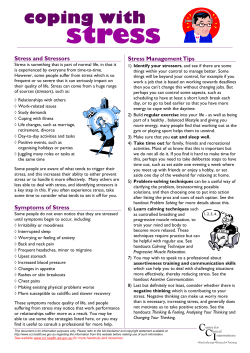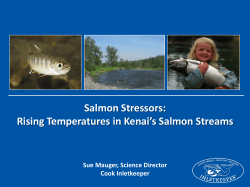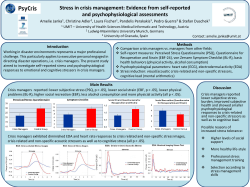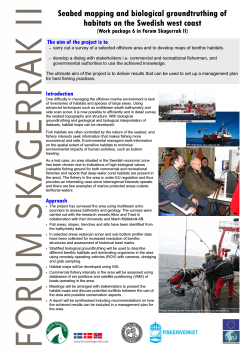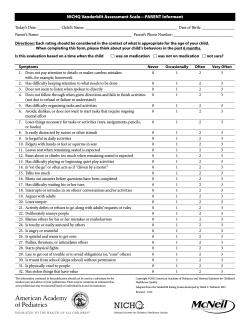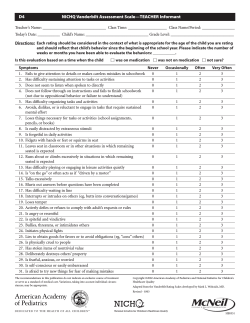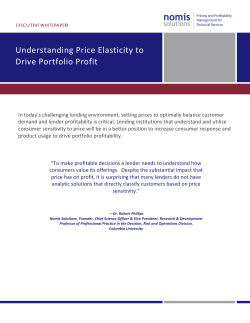
Quick Reference: Climate Change Vulnerability
Quick Reference: Climate Change Vulnerability Assessment for the North-central California Coast and Ocean The eight habitats assessed were scored as having moderate to moderate-high adaptive capacity, but highly variable degrees of exposure and sensitivity, ranging from low-moderate to moderatehigh. The most vulnerable habitats – beaches/dunes, estuaries, and rocky intertidal – exist at the land-sea interface. The 31 species assessed were scored as having highly variable adaptive capacity, from low to moderate-high, and highly variable exposure and sensitivity scores, from low-moderate to high. The majority of the ten species identified as being most vulnerable are those that use the three most vulnerable habitats. The five ecosystem services assessed generally scored higher for exposure and sensitivity than species or habitats, ranging from moderate-high to high. Adaptive capacity was more variable, ranging from lowmoderate to moderate-high. Those services that are provided primarily by the region’s coastal habitats were identified as being most vulnerable – flood and erosion protection, which is provided by estuarine and beach/dune habitat, carbon storage and sequestration, which is provided by estuarine habitat, and water purification, which is provided by estuarine and beach habitat. Climate and Non-Climate Stressors Stressors are ranked by decreasing mean sensitivity score averaged from assessment results; the number of resources that indicated each stressor as a sensitivity is also included. Stressors highlighted in red were identified as most impactful to the 3 most vulnerable habitats. Stressors that scored a high mean sensitivity for many resources (e.g. wave action and invasive species) may represent priorities for managers to address because they apply to multiple resources in the study region and have a high overall impact. Managers may also want to consider developing climate-smart adaptation strategies and actions that address multiple highranking climate and non-climate stressors together. Some stressors are tightly linked and may be considered as consequences of the same climate stressor, such as wave action and coastal erosion, which are consequences of increasing storm severity and frequency. Asterisk denotes those stressors identified by only 1 or 2 resources. Climate Stressor Storm severity/frequency Wave action Coastal erosion Salinity pH Sedimentation Dynamic ocean conditions (currents/mixing/stratification) Dissolved oxygen Sea surface temperature Sea level rise Air temperature Precipitation Turbidity* Upwelling* Wind* Pacific Decadal Oscillation* Average score 4.67 3.5 3.25 3.23 3.2 Number of resources 6 22 24 26 30 Non-Climate Stressor 3.17 3.14 4 29 Roads/Armoring Invasive and problematic species Aircraft and vessels Recreation Pollution and poisons (including oil spills and run-off) Land use change Overwater/underwater structures 3.08 3.04 2.94 2.81 2.54 3 5 3 4 24 27 18 21 26 2 1 1 1 Harvest Energy production Natural predation* Dredging * Boat groundings * Anthropogenic noise* Disease* Transportation * Researcher disturbance* Average score 3.88 3.78 3.67 3.54 3.43 Number of resources 8 17 3 13 31 3.33 3.25 14 4 3.07 2 4.5 4 3 5 5 2 1 20 6 2 2 2 1 1 1 1 Hutto, S.V., K.D. Higgason, J.M. Kershner, W.A. Reynier, D.S. Gregg. 2015. Climate Change Vulnerability Assessment for the North-central California Coast and Ocean. Marine Sanctuaries Conservation Series ONMS-15-02. U.S. Department of Commerce, National Oceanic and Atmospheric Administration, Office of National Marine Sanctuaries, Silver Spring, MD. 473 pp.
© Copyright 2025
